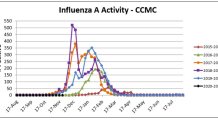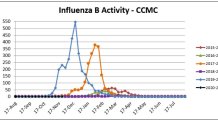This year's flu season is going hand in hand the COVID-19 pandemic.
North Texas doctors had urged people to get their flu shots in early October to prevent any further strain on health care workers fighting the novel coronavirus.
But now they’re seeing lower numbers in flu cases than ever before.
“A lot of it has to do with folks taking those precautions and even though they’re not taking it for the flu in particular, I think it’s just a healthy and pretty neat side effect of taking precautions for the COVID-19 pandemic,” said Dr. Ramon Kinloch, a pediatrician for Cook Children’s Forest Park.
In years past, flu numbers would usually start to spike in November and December. Currently, both Cook Children's and Children's Health hospitals are reporting unusually low flu cases this year.
“With the face coverings, you’re not able to spread those respiratory droplets, snot and all that fun stuff that people like to share around this time of year," said Kinloch. "And they’re just not gathering close together so that virus doesn’t have a chance to jump from person to person like it normally would.“
Take a look at these flu graphs from Cook Children's comparing different years of flu strains A and B. Each dot represents cases per week.

In the graph above, you can see the purple line spiking in November 2018, when the hospital had more than 500 cases in one week for Flu A.
Local
The latest news from around North Texas.
This particular strain also produced another smaller spike during the 2019-2020 flu season a year ago.
In the graph below for the flu B strain, the blue line shows cases peaked to more than 500 cases per week around November and December of last year.

In both graphs, the black dots at the very bottom represent this current 2020-2021 flu season.
“It's pretty much nonexistent," said Kinloch. “We know the flu virus still exists but we’re definitely not seeing it in the numbers where we have seen it in years past, especially at this time of year."
Dr. Kinloch said they’ve been issuing flu tests but so far this year, they've seen zero flu cases at their medical center.
“Last year, I think we had a pretty notable flu season, especially in the pediatric population. In all the years, last year was one of the worst with that population,” he said. “So we were really anticipating, 'OK, let’s brace ourselves' for a ‘twindemic’, with COVID-19 virus and the flu virus. But fortunately, we’re not seeing that."
Dallas Children's is reporting similar results.
Data shows for the month of November, the hospital had one positive case of the flu. At this same time last year, Children’s Health had 285 positive cases.
Dr. Kinloch said it's important that people continue to wear masks, social distance and avoid large gatherings until the threat of overwhelming healthcare workers has passed. Flu season lasts until March or April so it's not too late to get your flu shot.
“We definitely don’t want to see flu numbers rise in addition to COVID-19 numbers rising, because it is possible to be infected with both at the same time," he said. "And Lord knows we don’t want to see what effect that would have in our population. So continue to stay vigilant, stay aware."
While the lower flu cases is welcome news, doctors say their fight against COVID is only growing.
Cook Children’s and Children’s Health are reporting a rise in hospitalizations over the last few weeks, with both hospitals currently caring for more than a dozen COVID-19 patients each.



